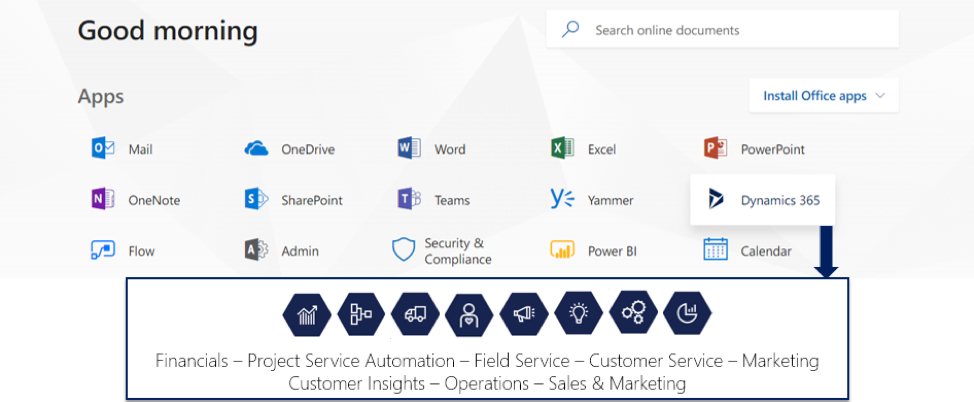The debate is always raging on between Microsoft Dynamics 365 and Salesforce over who holds the better CRM product. Frankly, unbiased advice is hard to come by, and I admit to having a little myself too. If you attended my webinar on May 29, you might have seen some of the core features that have tipped the scales in favour of Microsoft Dynamics 365 product. If you missed it, here’s your chance to get the Coles Notes. We’ll discuss the big 3 differentiators; integration, analytics, Microsoft’s vision.
Before we get into what’s different, let’s start with what is arguably the same between both products. They both offer your standard tools for maintaining a customer database, managing your leads and opportunities, and generating your sales forecasts and other reports. Both offer activity tracking, integration with Outlook, and mobile applications for Android and iOS. For a sales team, what else do you need? The answer, a lot!
Integration
Microsoft’s business solution Dynamic 365, falls under the Office 365 umbrella. Through this setup, they have enabled their customers to take advantage of all of their tools with seamless connectivity. Sales teams can connect to prospects through LinkedIn embedded in Microsoft Dynamics 365 CE (Dynamics 365 Customer Engagement, Microsoft’s rebranding of CRM), nurture their relationships through the connected tool. Then reps can generate a quote in Microsoft Dynamics 365 CE, pulling items from Business Central (ERP), and output the information into a dynamic Word template and “convert to PDF and email” using Outlook and track it right back into Dynamics 365 against my account, contact, and open opportunity.
I can then, from Outlook, create my follow up activities, which synchronize with CE, and store my files directly in CE, OneDrive, SharePoint or Teams. It doesn’t stop there. When the quote is approved I can submit my Order to Business Central (BC), view my Order status through Power BI dashboards and then have my Invoice synchronize right back into CE. Hopefully, you followed that whole chain of actions.
If not I’ll summarize just a few of the integrations in point form:
- LinkedIn integrates directly with CE and Outlook.
- Dynamics 365 for Customer Engagement (CRM) integrates with Business Central (ERP)
- Your accounts, contacts, quotes, orders, and invoices all integrate.
- Dynamics 365 is fully integrated with your Office suite of products.
- Pull data out of CE directly into Word and Excel
- View and interact with your CE data directly out of Outlook
- Dynamics 365 CE and BC integrate with Power BI
- This allows you to compare data sets to create powerful reports, as well as expose data that was once only available in 1 system into the other.
- Real life example: View your order backlog, shipping performance, item history, outstanding invoices, and more in your Customer Engagement system. This has been a massive productivity boost for Vox ISMs SMB customers.
- Dynamics 365 integrates with all of Microsoft’s document management tools including OneDrive, SharePoint and Teams.

Still reading? Aren’t Coles Notes usually shorter than this? Probably.
Analytics
Everyone wants big data, and now the challenge is what to do with it? Microsoft’s Power BI and AI-powered tools are offering up all the analytics organizations could ask for. Power BI can pull data from multiple sources including OData, SQL services, excel files and more. Now not only can you analyze all of your data, but AI will analyze it for you and suggest BI cubes to add to your reports. The analytics don’t stop there. Embedded in Dynamics 365 CE is the Relationship Assistant, which analyzes your interactions, your collected data, your emails, and more, and provides actionable insights for its users. It is like having your personal robot assistant.
Microsoft’s vision
Over $12billion spent each year in R&D and even more if you include acquisitions like LinkedIn (~$26billion purchase). Microsoft is committed to growing its cloud-based products and services and mobile capabilities. Their vision and execution have elevated Microsoft to their $1trillion status. Companies planning for the future can bet on Microsoft to get them there.
If watching videos on YouTube isn’t proof enough, you can always attend one of our free webinars and in-person events. Head over to our Events page to sign up.
Blog post by Jacob Steinfeld – Dynamics 365 Solution Architect

Jacob Steinfeld is a graduate of the Electronic Media Design program at Langara College in Vancouver, British Columbia, specializing in marketing & user interface design. For the last 3 years, Jacob has been a Dynamics 365 consultant with VOX ISM, supporting our various customers in the manufacturing, distribution, and healthcare industries. Jacob brings his sales and marketing expertise to his customers to aid in the implementation of new CRM systems.
